AI is transforming marketing in 2025, powering everything from personalized experience to smart search, Smart ad targeting, image recognition, data-driven results, and creative content creation. But what’s the intelligence behind it all?
In this blog, we’ll explore the types of AI in marketing, also called the AI techniques, because these are the very technologies that bring this Artificial intelligence to life.
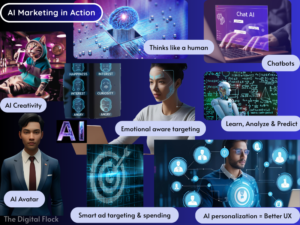
This blog unpacks the types of AI in marketing like Machine Learning, NLP, Computer Vision, Generative AI, and more, in a way that’s easy to understand and fun to read.
In 2025, these types of AI or AI techniques aren’t futuristic, they’re driving real-time strategies, creativity, and customer experiences.
And I know terms like “deep learning” or “natural language processing” can sound intimidating. But don’t worry! This isn’t a jargon-filled tech fest.
It’s a clear, simple guide to understanding the AI technologies or types of AI in Marketing that are driving marketing success in 2025.
Let’s dive in!
Table of Contents:
- Machine Learning: Teaching AI Through Data
- Deep Learning: AI Inspired by the Human Brain
- Natural Language Processing (NLP): Helps AI Speak Like People
- Generative AI: The AI That Creates, Not Just Predicts
- Large Language Models (LLMs): “Only Texts” Type of Generative AI
- Computer Vision: Teaching AI to “see”
- Bonus- Augmented Reality (AR): Digital meets Physical
Types of AI in Marketing
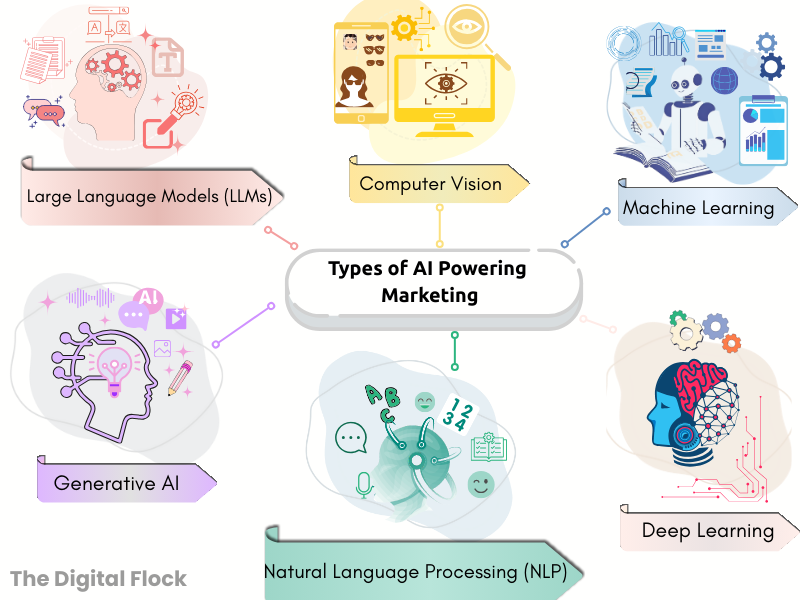
Now that we’ve laid out the different types of AI in marketing, let’s dive deeper into each one and see how they’re shaping strategies, driving creativity, and enhancing customer experiences in 2025.
Machine Learning: Teaching AI Through Data
Machine Learning is one of the most significant types of AI in marketing, powering personalized recommendations and dynamic customer experiences
Have you ever thought about how platforms like Amazon, Netflix, and Spotify seem to read your mind with their recommendations? If you’ve been binge-watching Friends, Netflix will likely recommend How I Met Your Mother. Similarly, if you browse running shoes on Amazon, you’ll soon see ads for sneakers, sportswear, or fitness gear across different websites.
How using Machine Learning benefited Netflix:
“‘Around 80% of the shows and movies people watch on Netflix come from our recommendations,” said the Machine Learning Director, Justin Basilico. (See the video)
This is what machine learning does. But, how does it do that?
A model learns by studying tons of data like customer behavior, website interactions, watching history and purchase history. Using this data, the model then makes highly accurate predictions.
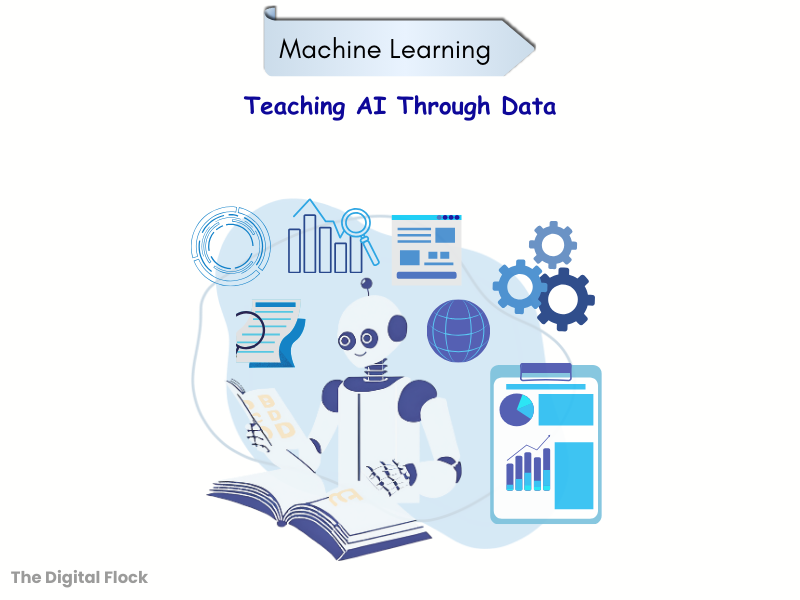
How Machine Learning Helps in Marketing?
1. Personalized Product Recommendations
When you browse for sneakers or add them to your cart, platforms like Google and Instagram use ML to track that interest. They don’t just look at your actions, but also compare them to people like you. So if others end up buying socks or smartwatches too, you’ll start seeing those in your feed next.
2. Real-Time Audience Updates
In traditional marketing, people were grouped into fixed categories like “college students” or “working moms” and kept seeing the same content even when their interests changed.
But machine learning updates your profile constantly, based on real-time behavior. So every time you click, scroll, ignore, or buy, it learns something new and tweaks what you see next.
So now your ads, product recommendations, and even email content can shift day-to-day, adapting to your most recent actions, not just a label someone assigned you months ago.
3. Predicts What Customers Want Next
ML doesn’t wait for your next move; it anticipates it. When you buy a yoga mat, it knows what people like you usually do next. If the pattern says most users follow that with protein powder or recovery drinks, then it starts showing those products proactively.
Therefore, these predictions come from your behavior and massive patterns of others like you. So you might start seeing:
- Ads for wellness drinks, fitness apps, or home workouts
- Content from influencers or brands in that space before you even search for it
So, it’s less “you looked, so we’ll remind you” and more “we know what you’ll probably want next so here it is.”
4. Smarter Ad Budget Allocation
Platforms like Meta and Google Ads use ML to watch where your ads perform best and then auto-adjust the spend. If Instagram Reels get more clicks than Facebook Stories, the budget shifts behind the scenes without a human touching it.
5. Smart Testing of Multiple Ad Versions
ML rapidly tests ad versions of the same ad, like different images, headlines, or CTA buttons, targeting tweaks, and timings to find what works. So, you don’t have to run an A/B test manually.
The system figures out which version of your ad gets more conversions, and then prioritizes it automatically.
Example: If more people click on a “Shop Now” button on the ad instead of “Try Me,” the system keeps the “Shop Now” version running.
6. Learns from What Customers Ignore
Even when you ignore something, ML takes note. If flashy product ads don’t work on you, next time you’ll see softer, story-based ads or influencer content instead. Silence is also a signal.
Deep Learning: AI Inspired by the Human Brain
A More Advanced Version of Machine Learning.
Deep learning takes it up a notch. It works just like machine learning, but on a deeper level, finding hidden patterns that humans might miss.
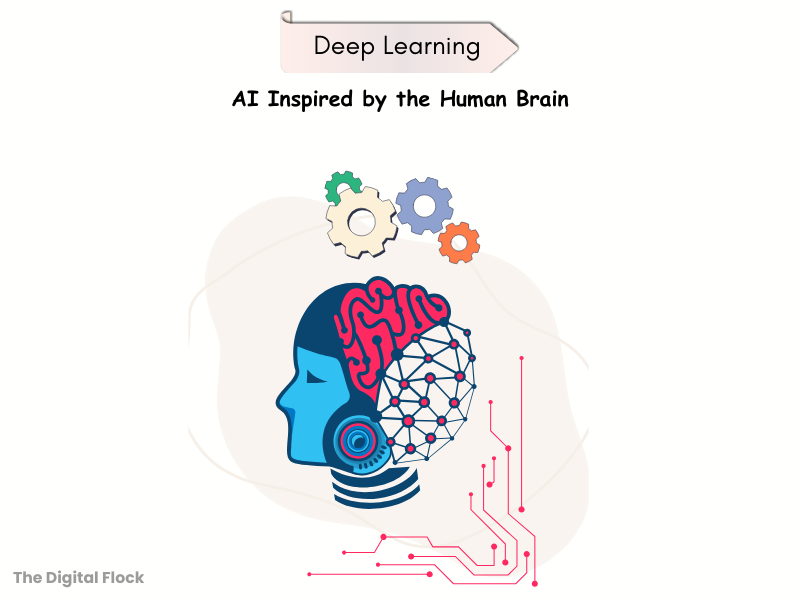
How Deep Learning helps in Marketing?
1. Detects Deeper User Patterns
Deep learning doesn’t just track what you do, but understands how you behave.
Netflix knows when you pause at emotional scenes or binge an entire series in one night. In digital marketing, this same intelligence tracks even the tiniest things you do.
Example: If you often zoom in on tech specs before buying, deep learning will show you ads that highlight details first because that’s what catches your eye.
2. Predicts Winning Ads Before Launch
Deep learning can guess which ads will perform best before they even go live.
Think of it as a practice session before the campaign launches.
It studies patterns in past ads, audience behavior, mood trends, and timing. Then, platforms like Meta (Facebook/Instagram), Google Ads, and Amazon run simulations behind the scenes.
They test ad versions in an online environment and predict which one will get more clicks, saves, or purchases.
3. Auto-Generates Personalized Ads Instantly
Deep learning can generate different ad versions on its own. It doesn’t just pick but creates, based on deeper signals.
You can see the difference in Machine Learning and Deep Learning here:
- Machine Learning tests versions and picks the winner
- Deep Learning creates personalized versions from scratch
For example: A clothing brand uses deep learning to create visuals:
- One user sees casual outfits at the beach
- Another sees formal wear in a modern office, all based on their browsing style and mood
4. Hyper-Personalization at Micro-Level
Deep learning personalizes ads beyond broad interests, it dives into tiny details.
Platforms like Amazon, Instagram, or Google track your behavior:
- Always hover over items priced under ₹2,000? AI learns that’s your comfort zone.
- Prefer earthy or pastel colors? You’ll start seeing more of them.
This way, every ad feels like it’s made just for you.
Natural Language Processing (NLP): Helps AI Speak Like People
Ever noticed how ChatGPT responds naturally? Or how Google understands voice searches like “Best coffee shops near me?” The answer lies in NLP.
NLP equips AI with the skills to understand how we talk and communicate back in a human-like way.
How NLP Learns:
- NLP is trained on real conversations, so it picks up how we naturally speak.
- NLP is trained using the texts found in books, online articles, and social media.
- NLP also Learns grammar, tone, and context to interact like a human.
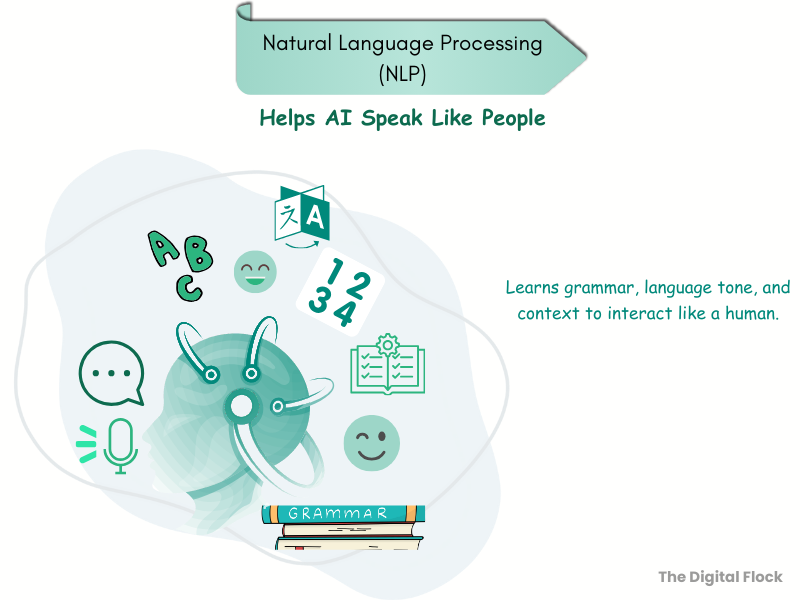
How does NLP help in Marketing?
1. Voice Search Optimization
NLP helps platforms like Google Assistant and Alexa understand spoken queries and respond accurately.
For instance, you ask Google, ‘Where’s the best pizza nearby?’, NLP understands what you mean and finds the best spots around you.
2. Chatbots & Instant Customer Support
AI-powered chatbots use NLP to interpret customer queries and provide quick, accurate responses in human language, understanding the customer’s intent and emotion offering context-aware replies.
3. Smarter SEO & Content That Ranks
Thanks to NLP, search engines now judge content based on meaning and relevance, not just on specific keywords.
As a result, this enables search engines like Google to understand user intent, delivering the most relevant content that answers their questions.
4. AI-Generated Text That Sounds Human
NLP (Natural Language Processing) enables AI to write content that feels natural and engaging, just like a human would.
Therefore, it helps marketers quickly create everything from ad headlines and email subject lines to blog intros and product descriptions.
Generative AI: AI That Creates, Not Just Predicts
Generative AI is one of the most talked-about forms of AI right now, transforming marketing with creativity and innovation.
When it comes to types of AI in marketing, it’s impossible not to mention Generative AI.
Traditional AI looks at data and predicts what’s next, but Generative AI takes it a step further by actually creating new content from scratch.
- It can generate fresh and original content in different forms like text, images, videos, audio, and even virtual avatars that look like human.
- Generative AI looks at patterns in existing data, like text, images, or sounds, and uses that to make completely new content.
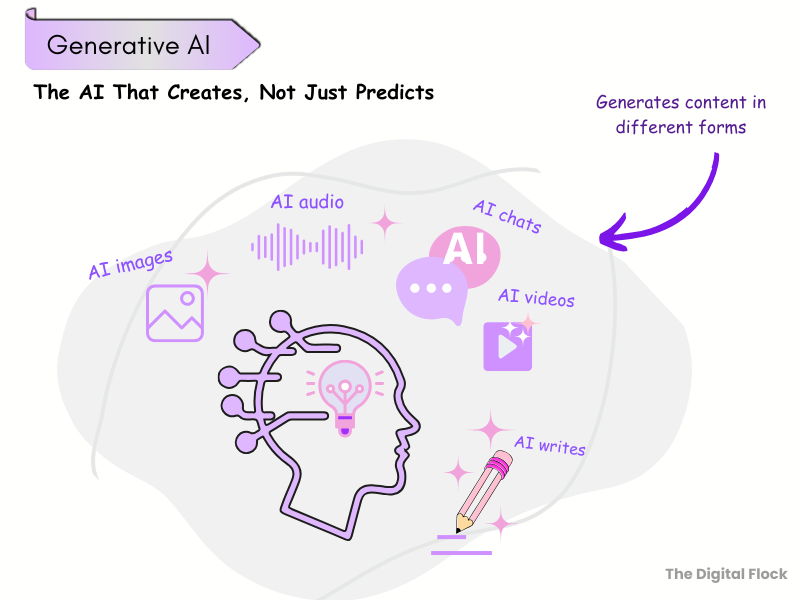
Why is Generative AI gaining traction in marketing over other AI types?
According to McKinsey’s 2025 Report (In Exhibit 8), only 33% of companies used Generative AI in early 2023. By mid-2024, that jumped to 71% because AI makes marketing faster and easier.
How Generative AI Helps in Marketing?
1. Create Original Content at Scale
- Generative AI allows you to quickly produce marketing content that resonates with your audience, feels new, and aligns with your brand.
- Whether it’s writing product descriptions, email campaigns, blog posts, or even unique ad scripts tailored for specific customer segments.
- In short, it combines creativity with data to generate content that feels personal and relevant.
2. Repurpose Content Intelligently
It can also take one piece of content (like a blog post) and transform it into an email newsletter, a LinkedIn carousel, or a short video script.
This saves time while keeping messaging consistent across platforms.
3. Design Entire Campaigns
- Brands now use Generative AI to ideate, build, and launch full-fledged campaigns.
- From scripting video ads, generating voiceovers, and creating never-seen-before images to producing entire talking avatars that speak directly to different audiences.
You can see how top brands like Cadbury, Absolut, Heinz, and more have successfully executed AI-powered marketing campaigns in this detailed case study on AI marketing campaigns by big brands.
All of it can be handled by AI with minimal human input.
4. Makes Brand Experiences Interactive
Generative AI helps brands make their experiences more immersive and two-way.
For instance, instead of static content, brands allow users to customize products, co-create visuals, or even generate their own brand stories through interactive AI tools.
For example, Coca-Cola’s “Create Real Magic” campaign was a great success, where users generated their own AI artwork to be featured on billboards.
5. Generate Personalized Landing Pages in Real Time
Some brands like Dynamic Yield (used by McDonald’s, Sephora, and IKEA) are starting to use Generative AI to dynamically generate tailored landing page visuals, copy, and layouts based on who’s visiting.
For example, a travel platform might instantly create personalized hero images and messages, like a solo mountain trek or a family-friendly beach scene, all thanks to AI and user data.
Generative AI is changing the game in marketing with its creativity, speed, and ability to personalize. It is enabling the brands to craft entire ads that feel human, emotional, and on-brand, all powered by AI.
Large Language Models (LLMs): “Only texts” Type of Generative AI
LLMs are a powerful subset of Generative AI designed specifically to understand and generate human-like text.
As the name suggests, they’re trained on Large Sets of language data including grammar, context, and tone which enables them to write, chat, answer questions, summarize content, and even “think” in ways that feel remarkably human.
For Example:
- ChatGPT, Claude, Gemini are all LLMs.
- AI tools like Midjourney are not an LLM (it generates images, not text).
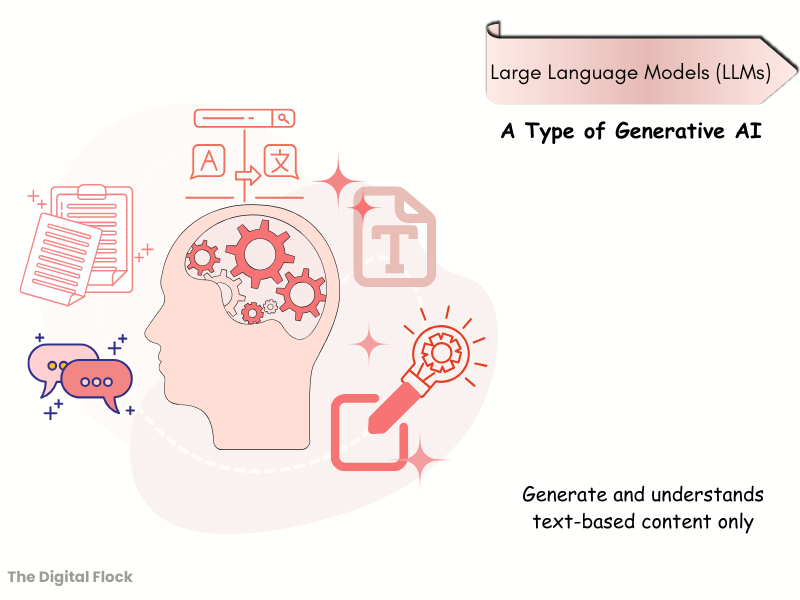
How do Large Language Models (LLMs) help Marketers?
1. Automate Human-Like Conversations
LLMs power AI chatbots that don’t just spit out FAQs but respond like humans, understand emotions, and guide users through complex journeys (like picking a product or solving an issue).
2. Supercharge Content Creation
Marketers use LLMs to write blogs, email copies, product descriptions, social media captions, and more, all while maintaining brand tone and voice.
They can even adjust language style based on the audience (formal, playful, concise, etc.).
3. Research & Summarize Insights in Seconds
LLMs like ChatGPT, Gemini, Claude are like mini-strategists on demand.
They can read lengthy reports, summarize key takeaways, simplify complex articles, extract trends, help in market research, and even suggest campaign ideas or content angles in minutes.
Therefore, with LLMs, marketing is evolving to be faster, efficient, and easier to grow.
They help marketers ideate, converse, and analyze, all in one tool.
Computer Vision: Teaching AI to “See”
Ever used Google Lens or Pinterest to find a product by snapping a photo? That’s Computer Vision. AI is capable of analyzing images and videos just as humans would.
How It Learns:
- Trained on millions of images and videos to recognize objects, faces, text, and scenes.
- Keeps getting better over time as it processes more visual data.
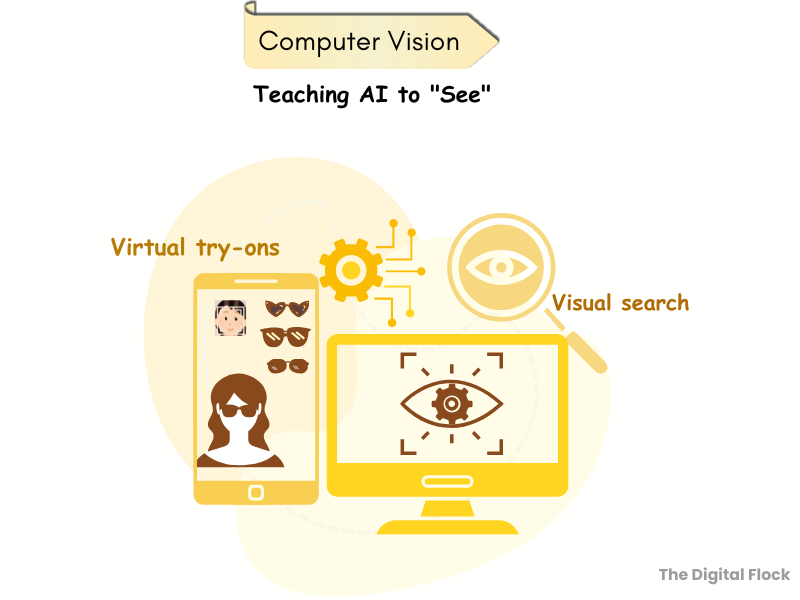
How Computer Vision Helps in Marketing?
1. AI-Powered Ad Placement
Platforms like YouTube and TikTok now scan video content in real time to understand what’s on screen like someone hiking, doing skincare, or drinking coffee and place super relevant ads alongside it.
Think product placement, but smarter and automated.
2. Virtual Try-Ons
With the help of Computer Vision and AR, users can try on lipstick, sunglasses, or sneakers through their phone camera, bringing the fitting room to their screen.
3. Social Listening via Images (Still Emerging)
- Some brands are now using AI to scan photos and posts shared by users on social media.
- This helps them identify things like brand logos, products, and even emotions, like a happy selfie with their product or a frustrated post about something damaged.
- This helps brands understand how and where their products are used, even when they aren’t tagged.
- Tools like Brandwatch and Google Cloud Vision are exploring this space.
4. Visual Search
AI helps users find products by analyzing images instead of keywords – just upload a photo, and it identifies similar or exact items to shop.
Example: Google Lens, Pinterest image search, etc.
Augmented Reality (AR): Digital meets Physical
What is Augmented Reality (AR)?
With Augmented Reality (AR), digital images or animations are layered on top of what you see in your physical surroundings in the real world.
So basically, it mixes virtual things, like characters or objects, with your surroundings, usually through your phone or device.
For example, IKEA’s Place app lets users visualize virtual furniture in their living room, and virtual try-ons of makeup on Sephora’s app.
Although Augmented Reality isn’t a standalone AI type, it works hand-in-hand with Computer Vision and Machine Learning to bring digital content into the physical world in real time

How Augmented Reality (AR) Helps in Marketing?
1. Interactive Ads
AR makes ads more fun and engaging like scanning a magazine page to unlock a 3D view of a product or interacting with a billboard using your phone.
2. Immersive Shopping
Customers can place virtual furniture in their living room or see how a lamp looks on their bedside table before they hit “Buy Now.”
For example, With Amazon’s AR View, customers can get a sense of how furniture, home decor, and other items like rugs or art pieces will look in their space.
While AR isn’t classified as its own AI type, it’s a powerful application of AI technologies that’s changing the way brands connect with customers, making experiences more interactive, visual, and personalized.
Final Thoughts on Types of AI in Marketing
To sum up,
AI is taking marketing to a whole new level in 2025, making it more powerful and effective. It’s making content more creative, user experiences more personal and customized, ads and spending more targeted and impactful, results more data-driven, and therefore, the whole process faster and more efficient.
With these types of AI in marketing, from Machine Learning and Natural Language Processing (NLP) to Computer Vision, Generative AI, Large Language Models (LLMs), and Augmented Reality (AR)- AI has moved beyond being just a trend; it’s driving more intelligent, customized, and innovative strategies.
But, it’s not just understanding us, it’s learning, adapting, and thinking almost like humans. And the best part? You don’t have to be a tech pro to work with AI.
Thus, by understanding the types of AI in marketing, businesses can deliver personalized, data-driven, creative, and more targeted results.
As AI evolves, marketers who embrace it will lead the future of digital marketing.
About the Author
AI marketing strategist & founder of The Digital Flock, specializing in AI tools, AI SEO, and content automation. She applies AI in real marketing workflows and documents the results through strategies, tutorials, and case studies to help marketers use AI practically.